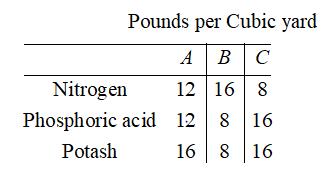
In Problems 33-38, construct a mathematical model in the form of a linear programming problem. (The answers in the back of the book for these application problems include the model). Then solve the problem using the big
Plant food. A farmer can use three types of plant food: mix

Want to see the full answer?
Check out a sample textbook solution
Chapter 6 Solutions
FINITE MATHMATICS F/ BUSI...-ACCESS
Additional Math Textbook Solutions
University Calculus: Early Transcendentals (4th Edition)
A Problem Solving Approach To Mathematics For Elementary School Teachers (13th Edition)
Introductory Statistics
College Algebra (7th Edition)
Calculus for Business, Economics, Life Sciences, and Social Sciences (14th Edition)
Elementary Statistics (13th Edition)
- 2 Real Analysis: Uniform Convergence Task: Refer to Question 2 in the provided document. Link: https://drive.google.com/file/d/1wKSrun-GlxirS31Z9qo Hazb9tC440 AZF/view?usp=sharingarrow_forward5 Topology: Compactness and Connectedness Task: Refer to Question 5 in the provided document. Link: https://drive.google.com/file/d/1wKSrun-GlxirS31Z9qo Hazb9tC440 AZF/view?usp=sharing 6 Numerical Methods: Root-Finding Algorithms Task: Refer to Question 6 in the provided document. Link: https://drive.google.com/file/d/1wKSrun-GlxirS31Z9qo Hazb9tC440 AZF/view?usp=sharingarrow_forward3 Calculus of Variations: Euler-Lagrange Equation Task: Refer to Question 3 in the provided document. Link: https://drive.google.com/file/d/1wKSrun-GlxirS31Z9qo Hazb9tC440 AZF/view?usp=sharing 4 Differential Equations: Stability Analysis Task: Refer to Question 4 in the provided document. Link: https://drive.google.com/file/d/1wKSrun-GlxirS3IZ9qo Hazb9tC440 AZF/view?usp=sharingarrow_forward
- Task: Complex Analysis: Residue Theorem Refer to Question 8 in the provided document. Link: https://drive.google.com/file/d/1wKSrun-GlxirS31Z9qoHazb9tC440 AZF/view?usp=sharing Task: Functional Analysis: Banach and Hilbert Spaces Refer to Question 9 in the provided document. Link: https://drive.google.com/file/d/1wkSrun-GlxirS31Z9qoHazb9tC440 AZF/view?usp=sharingarrow_forwardLinear Algebra: Eigenvalues and Eigenvectors er to page 1 for eigenvalue decomposition techniques. ructions: Analyze the matrix provided in the link to calculate eigenvalues and eigenvectors. Discuss how eigenvalues and eigenvectors are applied in solving systems of linear equations. Evaluate the significance of diagonalizability in matrix transformations. Link: [https://drive.google.com/file/d/1wKSrun-GlxirS31Z9qo Hazb9tC440AZF/view?usp=sharing]arrow_forward11 Set Theory: Cardinality of Infinite Sets Task: Refer to Question 11 in the provided document. Link: https://drive.google.com/file/d/1wKSrun-GlxirS31Z9qoHazb9tC440 AZF/view?usp=sharing 12 Partial Differential Equations: Heat Equation Task: Refer to Question 12 in the provided document. Link: https://drive.google.com/file/d/1wKSrun-GlxirS31Z9qoHazb9tC440 AZF/view?usp=sharingarrow_forward
- Task: Linear Algebra: Eigenvalues and Eigenvectors Refer to Question 1 in the provided document. Link: https://drive.google.com/file/d/1wKSrun-GlxirS31Z9qo Hazb9tC440 AZF/view?usp=sharingarrow_forwardCalculus: Multivariable Optimization r to page 2 for constrained optimization techniques. uctions: Analyze the function provided in the link and identify critical points using the Lagrange multiplier method. Discuss the importance of second-order conditions for determining maxima and minima. Evaluate applications of multivariable optimization in real-world problems. Link: [https://drive.google.com/file/d/1wKSrun-GlxirS31Z9qo Hazb9tC440AZF/view?usp=sharing]arrow_forwardNot use ai pleasearrow_forward
- Refer to page 3 for stability in differential systems. Instructions: 1. 2. Analyze the phase plane of the system provided in the link to determine stability. Discuss the role of Lyapunov functions in proving stability. 3. Evaluate the impact of eigenvalues of the Jacobian matrix on the nature of equilibria. Link: [https://drive.google.com/file/d/1wKSrun-GlxirS31Z9qoHazb9tC440AZF/view?usp=sharing]arrow_forwardRefer to page 10 for properties of Banach and Hilbert spaces. Instructions: 1. Analyze the normed vector space provided in the link and determine if it is complete. 2. Discuss the significance of inner products in Hilbert spaces. 3. Evaluate examples of Banach spaces that are not Hilbert spaces. Link: [https://drive.google.com/file/d/1wKSrun-GlxirS3IZ9qoHazb9tC440AZF/view?usp=sharing]arrow_forwardRefer to page 1 for eigenvalue decomposition techniques. Instructions: 1. Analyze the matrix provided in the link to calculate eigenvalues and eigenvectors. 2. Discuss how eigenvalues and eigenvectors are applied in solving systems of linear equations. 3. Evaluate the significance of diagonalizability in matrix transformations. Link: [https://drive.google.com/file/d/1wKSrun-GlxirS3IZ9qoHazb9tC440AZF/view?usp=sharing]arrow_forward
 Algebra: Structure And Method, Book 1AlgebraISBN:9780395977224Author:Richard G. Brown, Mary P. Dolciani, Robert H. Sorgenfrey, William L. ColePublisher:McDougal Littell
Algebra: Structure And Method, Book 1AlgebraISBN:9780395977224Author:Richard G. Brown, Mary P. Dolciani, Robert H. Sorgenfrey, William L. ColePublisher:McDougal Littell Algebra for College StudentsAlgebraISBN:9781285195780Author:Jerome E. Kaufmann, Karen L. SchwittersPublisher:Cengage Learning
Algebra for College StudentsAlgebraISBN:9781285195780Author:Jerome E. Kaufmann, Karen L. SchwittersPublisher:Cengage Learning

